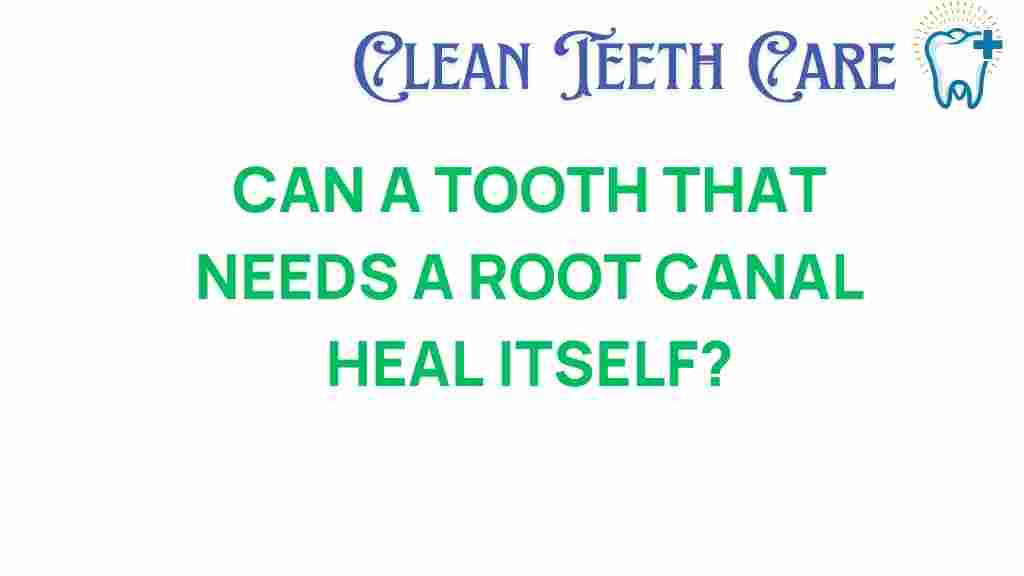Can Your Tooth Heal Itself? The Surprising Truth About Root Canals
When faced with tooth pain, many people wonder if their tooth can heal itself or if they will need a root canal. Dental health is critical, and understanding the mechanisms behind tooth healing and the role of endodontics can help you make informed decisions about your care. In this article, we’ll explore the surprising truths about root canals, tooth healing, and what to expect from dental treatments.
Understanding Tooth Healing
Teeth, unlike many other parts of the body, have limited self-repair capabilities. While the body can heal soft tissues and bones relatively quickly, teeth are made of hard enamel and dentin, which do not regenerate once damaged. This leads to the question: can your tooth heal itself?
- Enamel: The outer layer of the tooth, which protects it from decay, can become worn or damaged but cannot heal itself.
- Dentin: The layer beneath enamel can suffer from cavities, but once bacteria invade, self-repair is not possible.
- Pulp: The inner part of the tooth houses nerves and blood vessels. Damage to the pulp often necessitates a root canal.
While some minor issues like early-stage demineralization can be reversed through improved oral hygiene and dietary changes, significant damage typically requires professional intervention.
The Role of Root Canals in Dental Health
A root canal is a dental treatment designed to save a tooth that is badly decayed or infected. The procedure involves removing the infected pulp, cleaning the interior of the tooth, and sealing it to prevent further infection. Here’s a step-by-step breakdown of the root canal process:
Step-by-Step Process of a Root Canal
- Diagnosis: Your dentist will assess the tooth through X-rays to determine the extent of damage and infection.
- Anesthesia: Local anesthesia is administered to ensure you remain comfortable during the procedure.
- Pulp Removal: The dentist creates an opening in the crown of the tooth to access the pulp chamber and root canals, removing the infected tissue.
- Cleaning and Shaping: The interior is thoroughly cleaned and shaped to prepare for filling.
- Filling: Once cleaned, the canals are filled with a special material called gutta-percha to seal them.
- Restoration: Finally, a crown or filling is placed to restore the tooth’s function and appearance.
This treatment is crucial for maintaining dental health, as leaving a tooth infected can lead to severe consequences, including abscesses and tooth loss.
Signs You Might Need a Root Canal
Identifying the need for a root canal can sometimes be straightforward. Here are common symptoms:
- Severe Tooth Pain: Often described as a deep, throbbing pain that may worsen with pressure.
- Prolonged Sensitivity: Lingering sensitivity to hot or cold, even after the source is removed.
- Swelling and Tenderness: Swelling around the gums or face can indicate an underlying infection.
- Discoloration: A darkening of the tooth is often a sign of nerve damage.
If you experience any of these symptoms, it’s essential to consult a dentist promptly. Early intervention can often save the tooth and prevent more extensive dental treatments.
Dental Care Practices for Maintaining Tooth Health
While root canals are a vital procedure for some, maintaining good dental hygiene can help prevent the need for such treatments. Here are effective dental care practices:
- Regular Brushing: Brush your teeth at least twice a day with fluoride toothpaste.
- Floss Daily: Flossing helps remove plaque and food particles that can lead to cavities.
- Routine Dental Check-ups: Visit your dentist every six months for professional cleanings and examinations.
- Limit Sugary Foods: Reducing sugar intake can significantly lower the risk of cavities.
- Stay Hydrated: Drinking water can help wash away food particles and bacteria.
By incorporating these practices into your daily routine, you can enhance your oral hygiene and potentially prevent issues that lead to tooth pain and the need for root canals.
Can Teeth Heal Themselves? Debunking Myths
There are many myths surrounding tooth healing. Here are a few common misconceptions:
- Myth 1: Teeth can regenerate like bones. Truth: Teeth do not regenerate once damaged; they require professional dental care.
- Myth 2: Root canals are painful. Truth: With modern anesthesia and techniques, root canals are typically no more painful than getting a filling.
- Myth 3: You can ignore tooth pain. Truth: Ignoring tooth pain can lead to more severe issues, including loss of the tooth.
Understanding these myths can help you approach your dental health more accurately and responsibly.
Troubleshooting Tooth Pain
If you experience tooth pain, here are some troubleshooting tips to consider before seeking professional treatment:
- Rinse with Warm Salt Water: This can help reduce inflammation and clean the affected area.
- Over-the-Counter Pain Relievers: Non-prescription medications can alleviate discomfort temporarily.
- Cold Compress: Applying a cold compress to the outside of your cheek can help reduce swelling and numb pain.
- Avoid Certain Foods: Steer clear of extremely hot, cold, or sweet foods that may exacerbate pain.
While these tips can provide temporary relief, they should not replace professional dental care. If pain persists, it’s crucial to see a dentist.
Conclusion
In conclusion, while some aspects of dental health can be managed through diligent oral hygiene, significant issues like infections typically require professional intervention, such as a root canal. Understanding the limitations of tooth healing and the importance of dental care can empower individuals to take charge of their oral health.
Don’t ignore tooth pain; it’s your body’s way of signaling that something is wrong. Consult with your dentist for proper diagnosis and treatment options, including preventive measures to avoid future issues. For more information on dental treatments, you can visit this resource on dental care.
Remember, maintaining good oral hygiene and regular dental visits is essential for optimal dental health. Your smile deserves the best care!
This article is in the category Treatments and created by CleanTeethCare Team
